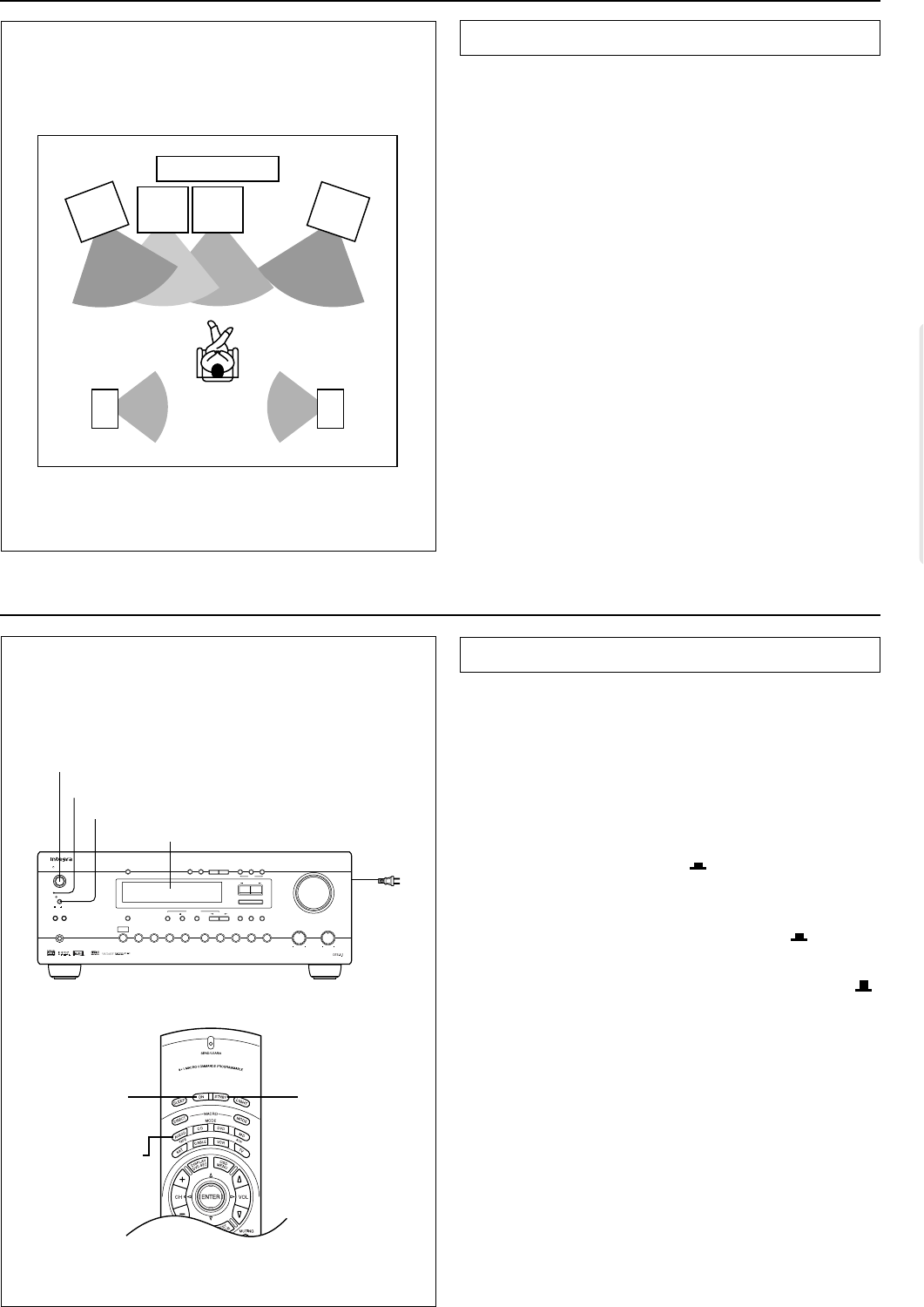
11
Positioning speakers
Speaker placement plays an important role in the repro-
duction of Surround sound. The placement of the speak-
ers varies depending on the size of the room and the wall
coverings used in the room. The illustration shows an
example of a layout for standard speaker placement.
Refer to this example when you position the speakers in
order to experience the best of Surround sound.
Standard speaker placement
For ideal Surround effects, all speakers should be
installed. If a center speaker or subwoofer is not con-
nected, the sound from the unused channel is properly
distributed to the connected speakers in order to pro-
duce the best Surround sound possible.
Front: The left, right, and center speakers should face the
seated listener and be placed at ear level. The center
speaker produces a richer sound image by enhancing
the perception of the sound’s source and movement.
Surround: Place the left and right Surround speakers
1 meter (3 feet) above the listener’s ear level and fac-
ing toward the sides of the room, making sure that the
listener is within the speakers’ dispersion angle. These
speakers produce the feel of a moving sound while cre-
ating the sensation of being in the middle of the action.
Subwoofer: Install a subwoofer with a built-in power ampli-
fier for powerful bass sounds. The placement of the sub-
woofer does not affect the final quality of the sound image
too much, so you can install it with the room layout in mind.
Refer to the speaker’s instruction manual for more details.
Positioning speakers
TV or Screen
Center
speaker
Surround
speaker
Right
Surround
speaker
Left
Listener
Sub-
woofer
speaker
Front
speaker
Left
Front
speaker
Right
Connecting the power
• Before you plug in the receiver, confirm that all con-
nections have been made properly.
• Turning on this receiver’s power may cause a momen-
tary power surge, which might interfere with other elec-
trical equipment, such as computers. If this happens, use
a wall outlet on a different circuit.
1. Plug the power cable into an AC wall outlet.
Note:
When you use the DTR-5.1 for the first time:
When the DTR-5.1 is shipped from the factory, the
Power switch is set to On ( ). Therefore, when you
plug in the power cord to the AC outlet, the Standby
indicator lights up and the unit enters Standby mode
as described in Step 2.
2. Press the Power switch to set it to the On( ) position
to place the receiver in Standby mode.
The Standby indicator will light up.
Press the Power switch again to set it to the Off ( )
position to turn off the power to the receiver.
3. Press the Standby/On button to turn on the receiver.
The display will light up and the Standby indicator will
be turned off.
If you press the Standby/On button, the receiver
returns to Standby mode.
Turning the power on from the remote controller:
1. Press the Power switch of the DTR-5.1 to turn on the
power to the unit.
2. Press the MODE AUDIO button.
3. Press the On button to turn on the power to the DTR-
5.1, or press the STNBY button to set the receiver in
standby mode.
• You cannot use the remote controller if the Power
switch on the receiver is set to Off.
• Set the volume level to minimum before you turn off
the power to the receiver.
Connecting the power
2. Power switch
3. Standby/On button
Standby indicator
Display
To wall
outlet
1.
Standby/On
Standby
Speakers
A
B
Phones
Bass
Treble
Master Volume
Multi CH
Input
Video 1
VCR
Video 2 Video 3 Tape
FM
AM Phono CDDVD
Dimmer
Memory
CH Level
Mode
Down UpTuning
FM Mode
Stereo
DSP
Re-EQDisplay
Listening Mode
CH Stereo5
/DTS
Surround
Digital/
Analog
SP/SYS
Setup
On
O
f
f
Power
Late Night/
Front Effect
LFE Level
Control
UpDown
Enter
Preset/Mode ADJ
3. ON button
2. MODE AUDIO
button
3. STNBY button
